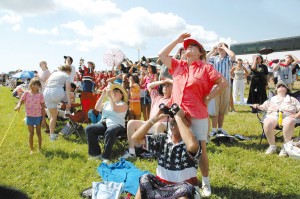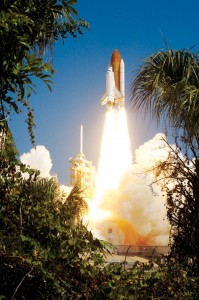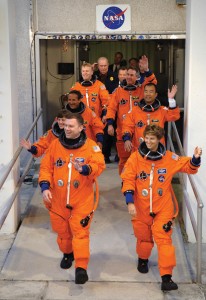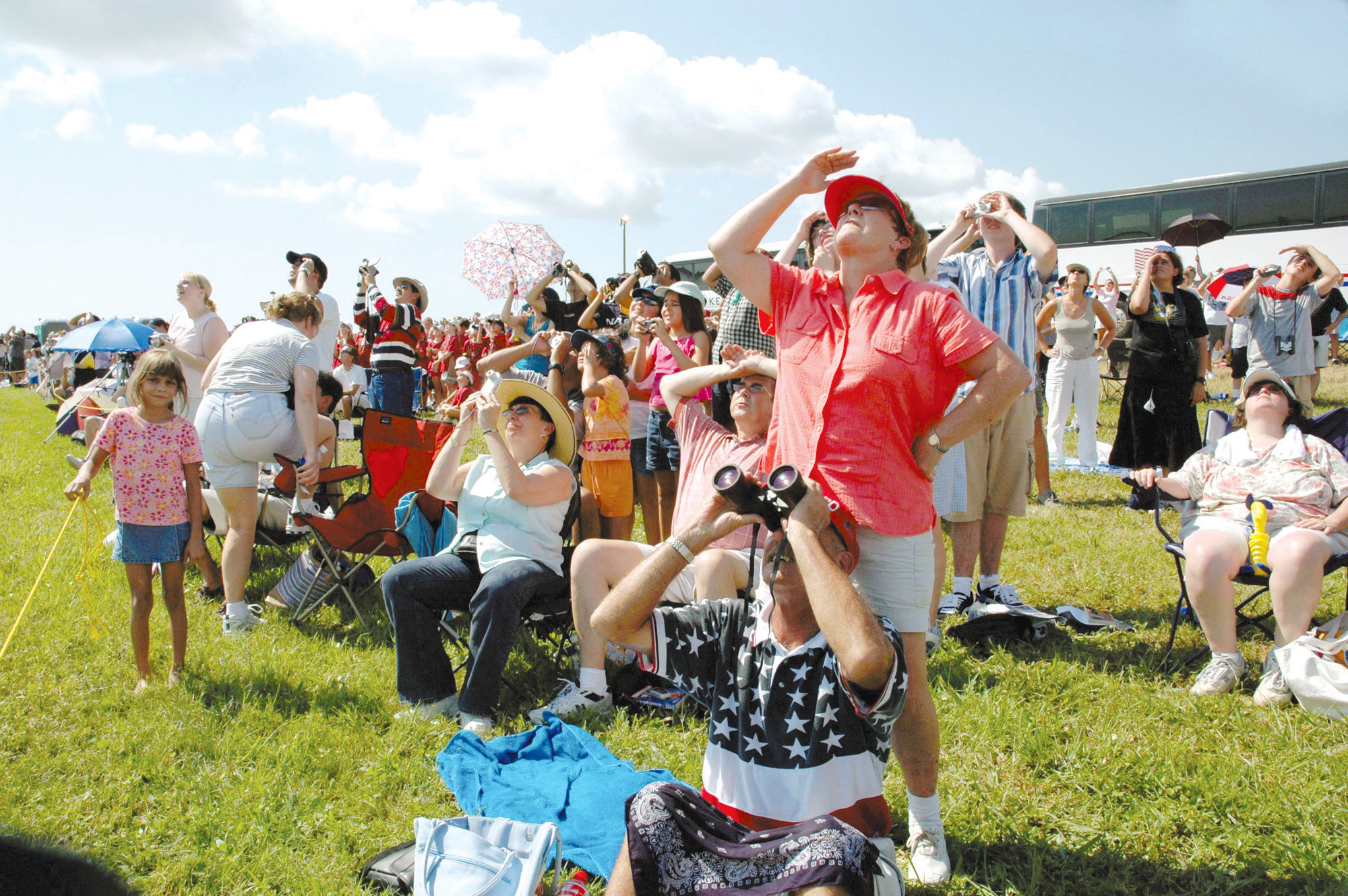By Chuck Weirauch

More than 200,000 people came to the Kennedy Space Center to view the launch of the STS-114 mission.
When Mission Commander Eileen Collins and pilot James Kelly landed Discovery at Edwards Air Force Base, Calif., August 9, to successfully complete the 114th shuttle mission, they once again showed the world that the basic design of the launch system is sound in spite of recent problems. That’s why Collins, who’s afraid to ride on roller coasters, still has faith in the space shuttle program, despite its ups and downs. It’s also why NASA plans to use modified shuttle components for future missions to the International Space Station, the moon and possibly Mars when the shuttle is retired in 2010.
The flying bug bit Eileen Collins early in life while she was growing up in Elmira, N.Y. Born in 1956, when scientists still weren’t sure that humans could even fly in space—let alone actually build a vehicle that could take them there—she grew up dreaming about flying. Rather than rockets, her inspiration came from being raised in the city where the National Soaring Museum is located. Watching gliders take off from nearby Harris Hill during summer camps provided her with the vision to earn her private pilot’s license and later join the Air Force and NASA.
That view from Harris Hill has now expanded to become the entire planet, with Collins now having flown in orbit around the Earth for more than 800 hours during four space shuttle missions. That’s the amount of time she’s accumulated in space after two missions as mission commander, as well as two as pilot, another crew position she pioneered for women in 1995.
“It was an honor for me to be chosen to be the first woman to command a space shuttle in 1999, but I also see it as an evolutionary process,” Collins said in an earlier interview, before the STS-114 mission. “I wouldn’t have been able to do so if it weren’t for all of the people, the women in particular, who’ve gone before me and set the stage to bring women into aviation.”
At this point, though, it’s anyone’s guess as to when Collins or any other NASA astronaut will fly again. With the shuttle grounded indefinitely because of problems with foam insulation debris from its external fuel tank that the STS-114 mission was hoped to prove to have been resolved, not only the shuttle program but also the entire U.S. manned space flight initiative hangs in the balance. That’s because any future launch vehicle beyond the space shuttle will still depend on the design and reliability of shuttle technology.
Ups and downs typical
Even with the latest disappointment of the external tank foam problems, those who have worked on the shuttle program and most of its fans and supporters will tell you that the latest developments are just typical of the roller-coaster, awe-inspiring highs and gut-wrenching lows that they’ve experienced throughout the 24-year history of the program. The STS-114 mission is a case in point.
More than 250,000 people traveled to the area around Kennedy Space Center as they gathered July 13 to witness the first attempt to launch the second Return to Flight mission. Nearly 3,000 news media representatives from around the world, especially Japan, had traveled to the KSC press site to cover the event as well.
Ironically, the two and a half years these space fans had waited since the Space Shuttle Columbia disaster on mission STS-107, during its reentry on Feb. 1, 2003, nearly matched the amount of time from the Challenger mishap on mission STS-51-L on Jan. 28, 1986, to the first Return to Flight STS-26 mission that lifted off on Sept. 29, 1988.
Unfortunately, they had to return to witness a successful launch of the mission on July 26, only to be stunned the next day, when NASA grounded the shuttle once again because of the recurring problem of foam insulation breaking off from the external tank.
The crews aboard the orbiter Discovery and the International Space Station also expressed disappointment when they learned of the problem and the space agency’s decision to ground the shuttle fleet until a solution could be found. However, their dismay didn’t detract them from their primary mission, testing and documenting the effectiveness of the Return to Flight efforts to resolve flight safety issues and delivering 15 tons of long overdue supplies and equipment to the orbital station, a backlog of materials nearly three years overdue.

Space Shuttle Discovery lifts off from Launch Pad 39B at 10:39 a.m., on July 26, to begin the STS-114 mission to the International Space Station.
“We’re staying focused on the mission and we now are in good hands with the people on the ground,” Collins said on the fourth day of the STS-114 flight. “I love being in space. It’s magical up here.”
In addition to performing all of the docking and undocking maneuvers with the space station, Collins also piloted Discovery through a 360-degree flip close by the ISS so that station crew members could take photos of the orbiter’s thermal protection system tiles to inspect for any possible damage caused by pieces of external tank foam insulation. She’s acknowledged by her colleagues, almost all top pilots themselves, as a natural pilot capable of handling such complex maneuvers with coolness and aplomb.
Collins perfected these skills prior to joining NASA while in the Air Force, when she logged more than 5,000 hours of flight time in more than 30 types of aircraft. She also had honed her skills to the point of becoming only the second woman pilot to graduate from the service’s test pilot school, achieving the rank of lieutenant colonel in the process.
Stephen Robinson, STS-114 mission specialist-2, described Collins’ piloting skills as those akin to a natural-born musician.
“It comes down to almost the artistry of just having mastered the machine,” Robinson said. “She’s got it. Boy, has she got it.”
Robinson, along with Soichi Noguchi, Japan Aerospace Exploration Agency astronaut and mission specialist, performed three spacewalks during the 12-day STS-114 mission. During their first spacewalk, they made a visual inspection of the orbiter’s wings to look for signs of tile damage. On the second, they conducted experiments in Discovery’s payload bay to try out newly developed methods of repairing tiles in space.
The third trip outside the shuttle was devoted to adding new equipment to the ISS and repairing one of the station’s faulty mechanical systems. Robinson also conducted the first-ever repair of the shuttle orbiter’s thermal protection system while in flight.
Onboard Discovery along with Collins, Kelly, Noguchi and Robinson were mission specialists Andy Thomas, Wendy Lawrence and Charles Camarda. They conducted in-cabin flight safety experiments during the mission. Thomas had flown on three previous shuttle missions and also served aboard the Russian space station Mir as flight engineer 2 for 141 days in 1998. Lawrence, a native of Jacksonville, Fla., had also flown three times previously as a mission specialist and had served as the director of operations for NASA at the Gagarin Cosmonaut Training Center in Star City, Russia, in 1996. Camarda, a NASA employee since 1974 and the director of the space agency’s Thermal Structures Laboratory, was on his first spaceflight.
Design by budget
With all of the space shuttle problems with external tank insulation, it’s ironic that the original designs for the vehicle didn’t include this insulation. In fact, the configuration of the present-day design space plane, with its reusable strap-on solid rocket boosters affixed to the disposable tank, bears only some resemblance to the all-liquid-fueled reusable rocket ship originally proposed to Congress in the early 1970s.
Budget cuts and the Congress-mandated requirement to make the shuttle program pay for itself through commercial launches and a 25-launch-per-year schedule led to the need to adopt the proven 1950s strap-on booster technology from the Titan rocket program, the failure of which in 1986 led to the tragic end of the STS-51-L mission. Some intimately familiar with the shuttle program (including this writer) also say that the forced redesign of the shuttle’s liquid fuel tank from the proposed original could well have been the root cause of the loss of the orbiter Columbia in 2003 and present-day problems.
Limited with budget constraints, shackled with military launches and burdened with unrealistic expectations, the shuttle program has so far had limited success in reaching its one-time launch goal. The highest number of launches, nine in 1985, was followed by eight in 1997, when all of the missions lifted off on the scheduled launch day. However, that record fell the next year, with only five launches taking place in 1998.

L to R: STS-114 Pilot James Kelly and Mission Commander Eileen Collins lead the rest of the mission crew out to the Astrovan that will take them to Launch Pad 39B on July 26.
In 1999, the launch of the STS-103 mission was scrubbed a record nine times. Throughout the 1990s, launch delays of one to two months and more due to mechanical problems occurred all too often. One such delay in 1990, caused by a hydrogen fuel leak in the quick-disconnect umbilical between the orbiter and the external tanks, lasted more than three months and was viewed by some at the time as a problem that could have ended the shuttle program.
More success than failure
In spite of all of its problems, the space shuttle program has provided some of the most spectacular successes for NASA and the United States during the country’s longest and arguably most successful manned launch program in terms of its accomplishments. Some of the most notable missions included the launch of three of what the space agency considers to be among its most important orbiting scientific research platforms: the Hubble Space Telescope in 1990 and subsequent repair missions, the Compton Gamma Ray Observatory in 1991, and the Chandra X-Ray Observatory in 1999.
The most significant interplanetary mission was the launch of the Galileo spacecraft aboard the orbiter Discovery in 1989. The space shuttle has also lifted nearly all of the components of the ISS into orbit. Hundreds of microgravity experiments designed to lead to medical breakthroughs, advances in materials science, physics, human biological research and even antimatter have been conducted by shuttle crew members in numerous onboard Spacelab and SPACEHAB modules, with the astronauts being the subjects of the experiments themselves.
The space shuttle was designed to be a “space truck” that would provide frequent and inexpensive access to space. Instead, it became a space Ferrari, with all of the thrilling performance and frustrating mechanical problems of such an exotic car. In spite of all its problems, however, even its critics would have to agree that the shuttle has played an important role in the advancement of science.
Components to live on
After the space shuttle is retired in 2010, some of its components may live on as critical parts of NASA’s proposed new manned launch vehicles to send crews to the ISS, the moon and perhaps even Mars. According to the space agency’s Exploration Systems Architecture Study just released this August, one of the shuttle’s solid rocket boosters would make up the first stage of the new manned crew vehicle.
One of the shuttle orbiter’s liquid-fueled motors would power the second stage. Sitting atop this launch vehicle would be the Apollo-program-like crew exploration vehicle. This combination would be used to send three astronauts to the ISS, beginning in 2011. This effort is already underway, with NASA having awarded contracts for initial design concepts to Lockheed Martin and a Northrop Grumman-Boeing team in July of this year. The space agency is to select a winner of this competition in July 2006.
For lunar missions, a new Cargo Vehicle with stages derived from shuttle external tanks and propelled by two modified shuttle solid rocket motors and five orbiter liquid-fueled engines would boost a lunar lander, a larger, four-person version of the CEV and a stage into Earth orbit. The lander and CEV would then be propelled from Earth orbit to the moon by the rocket-powered stage. The current shuttle configured with these engines has nearly the same lift capability as the Saturn V rocket used on Apollo lunar missions.
Once in orbit, the CEV and lunar lander would be propelled to the moon by their attached third stage. All CEV crews would return to Earth in the style of the Apollo, Gemini and Mercury programs, via a capsule with an ablative heat shield and parachutes attached to the capsule, only this time landing in Arizona or New Mexico.
“I know our women will do great aboard the International Space Station, and when we send people to the moon and to Mars, women will be an integral part of those crews,” Collins said. “Eventually, having women in these roles won’t be news anymore. It will be accepted and expected. I am setting a precedent for women to follow. With that in mind, I want to do the best job that I can.”
Chuck Weirauch is a former public affairs writer for NASA at KSC. He was employed there from 1988 to 1998, during what now can be considered the high point of the space shuttle program.











